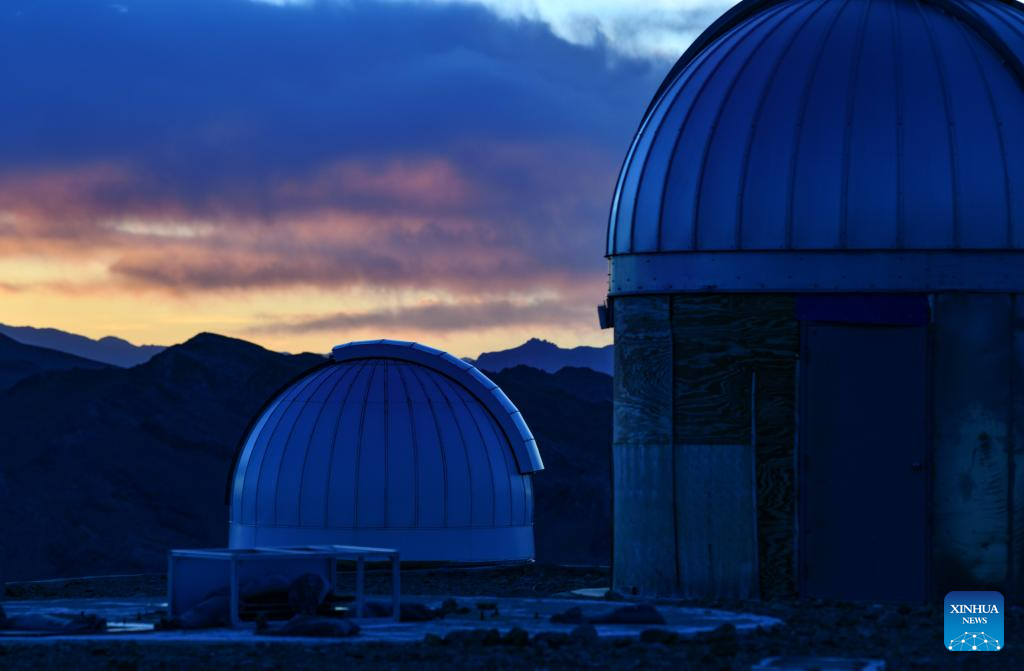
This photo taken on May 22, 2023 shows the Ngari Observatory at sunset in Ngari Prefecture, southwest China's Tibet Autonomous Region.
You Xianlong, a 36-year-old resident engineer at the Ngari Observatory in Tibet Autonomous Region, is responsible for equipment observation and operation maintenance along with seven colleagues. He is also the longest-serving engineer at the observatory.
You's career began in 2006 when he met Yao Yongqiang, a scientist at the National Astronomical Observatories under the Chinese Academy of Sciences (CAS), who was looking for workers to conduct long-term measurements in challenging plateau environments. Since then, You has been working at the Ngari Observatory for 17 years.
Selecting an observatory site is a complex process that involves examining terrain, geology, and support conditions. It also requires years of measurement and evaluation of factors such as the number of clear nights, astronomical seeing conditions, precipitable water vapor (PWV), and aerosol optical depth (AOD). These factors are closely related to astronomical observations.
Tibet's Ngari region, with an average altitude of over 4,500 meters, has proven to be an ideal location for establishing an astronomical observation base with full bandwidth.
From 2006 to 2011, the observatory's site selection team decided to construct an observation platform on a ridge south of Shiquanhe Town. You Xianlong and his colleagues took turns to keep a watch on the construction site. A typical round of shift would last at least three months.
During that period, You Xianlong and his colleagues faced a lot of difficulties such as limited food choices and threaten from wild animals.
In 2011, the observational platform was completed, marking the inception of the Ngari Observatory.
After over ten years of construction, the Ngari Observatory has now become one of the best astronomical observatories in the Northern Hemisphere. Yao Yongqiang believes that the facility will promote China's exploration into terrestrial planets and extraterrestrial life.
In the future, the observatory plans to build telescopes with diameters greater than ten meters. This prospect excites You Xianlong.
"I look forward to that day," said You Xianlong. "I am willing to stay on and prepare for the implementation of future large telescopes and scientific research projects." (Xinhua/Jigme Dorje)
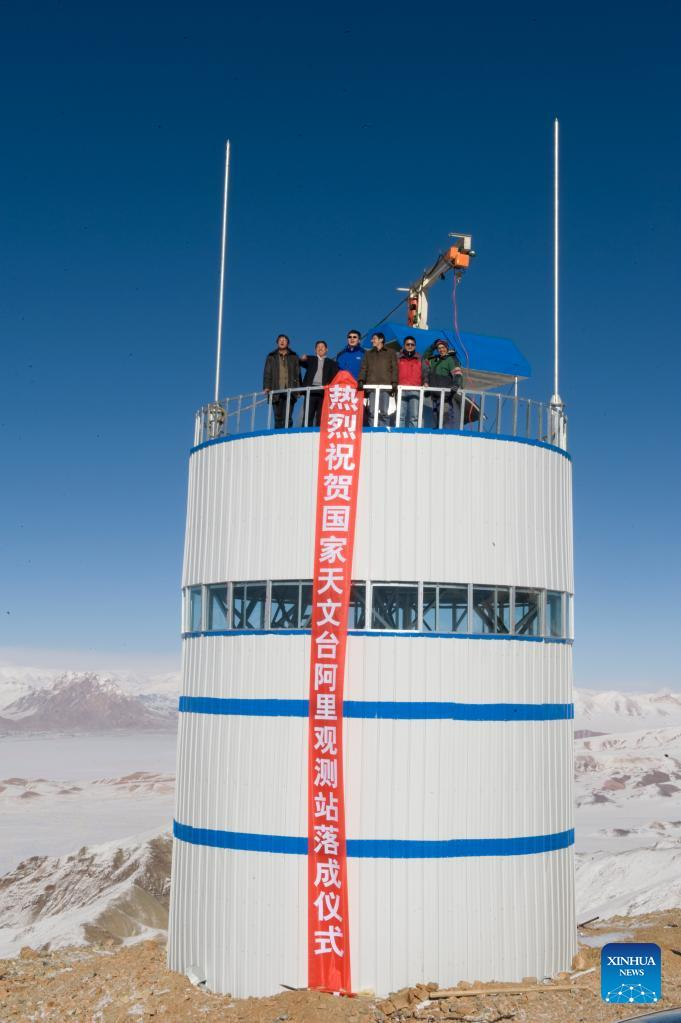
This file photo taken in 2011 shows the first observation tower of the Ngari Observatory in Ngari Prefecture, southwest China's Tibet Autonomous Region.
You Xianlong, a 36-year-old resident engineer at the Ngari Observatory in Tibet Autonomous Region, is responsible for equipment observation and operation maintenance along with seven colleagues. He is also the longest-serving engineer at the observatory.
You's career began in 2006 when he met Yao Yongqiang, a scientist at the National Astronomical Observatories under the Chinese Academy of Sciences (CAS), who was looking for workers to conduct long-term measurements in challenging plateau environments. Since then, You has been working at the Ngari Observatory for 17 years.
Selecting an observatory site is a complex process that involves examining terrain, geology, and support conditions. It also requires years of measurement and evaluation of factors such as the number of clear nights, astronomical seeing conditions, precipitable water vapor (PWV), and aerosol optical depth (AOD). These factors are closely related to astronomical observations.
Tibet's Ngari region, with an average altitude of over 4,500 meters, has proven to be an ideal location for establishing an astronomical observation base with full bandwidth.
From 2006 to 2011, the observatory's site selection team decided to construct an observation platform on a ridge south of Shiquanhe Town. You Xianlong and his colleagues took turns to keep a watch on the construction site. A typical round of shift would last at least three months.
During that period, You Xianlong and his colleagues faced a lot of difficulties such as limited food choices and threaten from wild animals.
In 2011, the observational platform was completed, marking the inception of the Ngari Observatory.
After over ten years of construction, the Ngari Observatory has now become one of the best astronomical observatories in the Northern Hemisphere. Yao Yongqiang believes that the facility will promote China's exploration into terrestrial planets and extraterrestrial life.
In the future, the observatory plans to build telescopes with diameters greater than ten meters. This prospect excites You Xianlong.
"I look forward to that day," said You Xianlong. "I am willing to stay on and prepare for the implementation of future large telescopes and scientific research projects." (Xinhua)
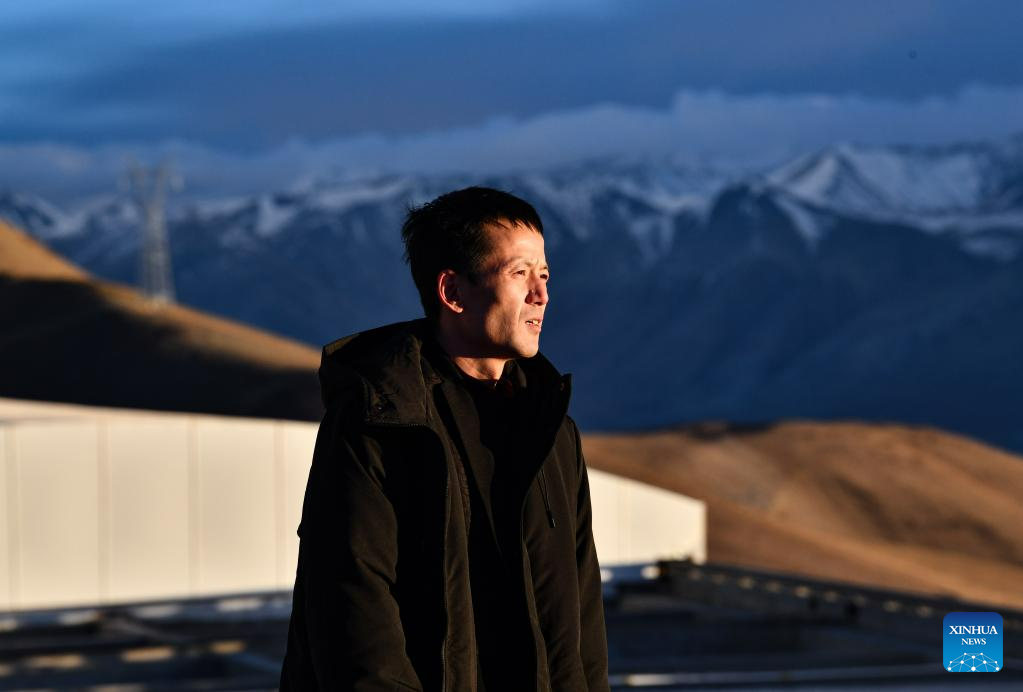
You Xianlong looks into the distance at the Ngari Observatory in Ngari Prefecture, southwest China's Tibet Autonomous Region, May 24, 2023.
You Xianlong, a 36-year-old resident engineer at the Ngari Observatory in Tibet Autonomous Region, is responsible for equipment observation and operation maintenance along with seven colleagues. He is also the longest-serving engineer at the observatory.
You's career began in 2006 when he met Yao Yongqiang, a scientist at the National Astronomical Observatories under the Chinese Academy of Sciences (CAS), who was looking for workers to conduct long-term measurements in challenging plateau environments. Since then, You has been working at the Ngari Observatory for 17 years.
Selecting an observatory site is a complex process that involves examining terrain, geology, and support conditions. It also requires years of measurement and evaluation of factors such as the number of clear nights, astronomical seeing conditions, precipitable water vapor (PWV), and aerosol optical depth (AOD). These factors are closely related to astronomical observations.
Tibet's Ngari region, with an average altitude of over 4,500 meters, has proven to be an ideal location for establishing an astronomical observation base with full bandwidth.
From 2006 to 2011, the observatory's site selection team decided to construct an observation platform on a ridge south of Shiquanhe Town. You Xianlong and his colleagues took turns to keep a watch on the construction site. A typical round of shift would last at least three months.
During that period, You Xianlong and his colleagues faced a lot of difficulties such as limited food choices and threaten from wild animals.
In 2011, the observational platform was completed, marking the inception of the Ngari Observatory.
After over ten years of construction, the Ngari Observatory has now become one of the best astronomical observatories in the Northern Hemisphere. Yao Yongqiang believes that the facility will promote China's exploration into terrestrial planets and extraterrestrial life.
In the future, the observatory plans to build telescopes with diameters greater than ten meters. This prospect excites You Xianlong.
"I look forward to that day," said You Xianlong. "I am willing to stay on and prepare for the implementation of future large telescopes and scientific research projects." (Xinhua/Jigme Dorje)
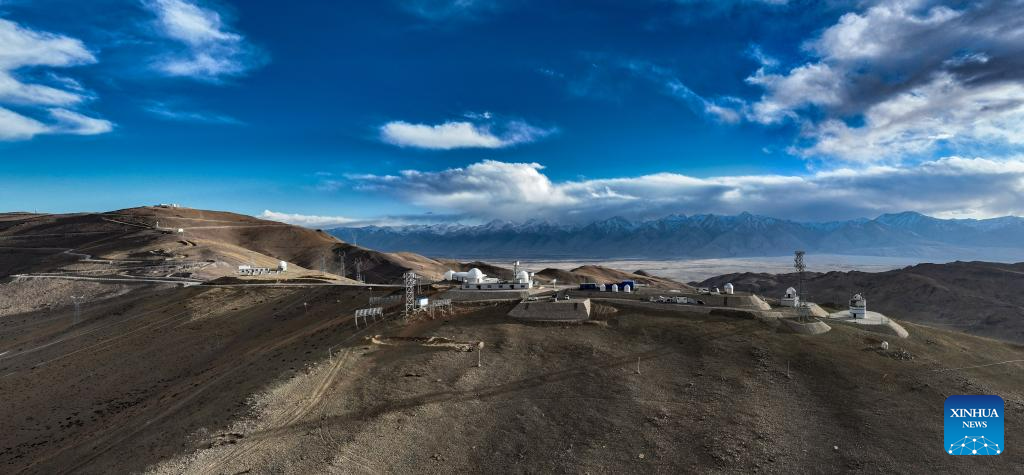
This photo taken on May 22, 2023 shows the Ngari Observatory in Ngari Prefecture, southwest China's Tibet Autonomous Region.
You Xianlong, a 36-year-old resident engineer at the Ngari Observatory in Tibet Autonomous Region, is responsible for equipment observation and operation maintenance along with seven colleagues. He is also the longest-serving engineer at the observatory.
You's career began in 2006 when he met Yao Yongqiang, a scientist at the National Astronomical Observatories under the Chinese Academy of Sciences (CAS), who was looking for workers to conduct long-term measurements in challenging plateau environments. Since then, You has been working at the Ngari Observatory for 17 years.
Selecting an observatory site is a complex process that involves examining terrain, geology, and support conditions. It also requires years of measurement and evaluation of factors such as the number of clear nights, astronomical seeing conditions, precipitable water vapor (PWV), and aerosol optical depth (AOD). These factors are closely related to astronomical observations.
Tibet's Ngari region, with an average altitude of over 4,500 meters, has proven to be an ideal location for establishing an astronomical observation base with full bandwidth.
From 2006 to 2011, the observatory's site selection team decided to construct an observation platform on a ridge south of Shiquanhe Town. You Xianlong and his colleagues took turns to keep a watch on the construction site. A typical round of shift would last at least three months.
During that period, You Xianlong and his colleagues faced a lot of difficulties such as limited food choices and threaten from wild animals.
In 2011, the observational platform was completed, marking the inception of the Ngari Observatory.
After over ten years of construction, the Ngari Observatory has now become one of the best astronomical observatories in the Northern Hemisphere. Yao Yongqiang believes that the facility will promote China's exploration into terrestrial planets and extraterrestrial life.
In the future, the observatory plans to build telescopes with diameters greater than ten meters. This prospect excites You Xianlong.
"I look forward to that day," said You Xianlong. "I am willing to stay on and prepare for the implementation of future large telescopes and scientific research projects." (Xinhua/Jigme Dorje)

You Xianlong (L) and his colleague Tang Peng discuss data collected at the Ngari Observatory in Ngari Prefecture, southwest China's Tibet Autonomous Region, May 23, 2023.
You Xianlong, a 36-year-old resident engineer at the Ngari Observatory in Tibet Autonomous Region, is responsible for equipment observation and operation maintenance along with seven colleagues. He is also the longest-serving engineer at the observatory.
You's career began in 2006 when he met Yao Yongqiang, a scientist at the National Astronomical Observatories under the Chinese Academy of Sciences (CAS), who was looking for workers to conduct long-term measurements in challenging plateau environments. Since then, You has been working at the Ngari Observatory for 17 years.
Selecting an observatory site is a complex process that involves examining terrain, geology, and support conditions. It also requires years of measurement and evaluation of factors such as the number of clear nights, astronomical seeing conditions, precipitable water vapor (PWV), and aerosol optical depth (AOD). These factors are closely related to astronomical observations.
Tibet's Ngari region, with an average altitude of over 4,500 meters, has proven to be an ideal location for establishing an astronomical observation base with full bandwidth.
From 2006 to 2011, the observatory's site selection team decided to construct an observation platform on a ridge south of Shiquanhe Town. You Xianlong and his colleagues took turns to keep a watch on the construction site. A typical round of shift would last at least three months.
During that period, You Xianlong and his colleagues faced a lot of difficulties such as limited food choices and threaten from wild animals.
In 2011, the observational platform was completed, marking the inception of the Ngari Observatory.
After over ten years of construction, the Ngari Observatory has now become one of the best astronomical observatories in the Northern Hemisphere. Yao Yongqiang believes that the facility will promote China's exploration into terrestrial planets and extraterrestrial life.
In the future, the observatory plans to build telescopes with diameters greater than ten meters. This prospect excites You Xianlong.
"I look forward to that day," said You Xianlong. "I am willing to stay on and prepare for the implementation of future large telescopes and scientific research projects." (Xinhua/Jigme Dorje)
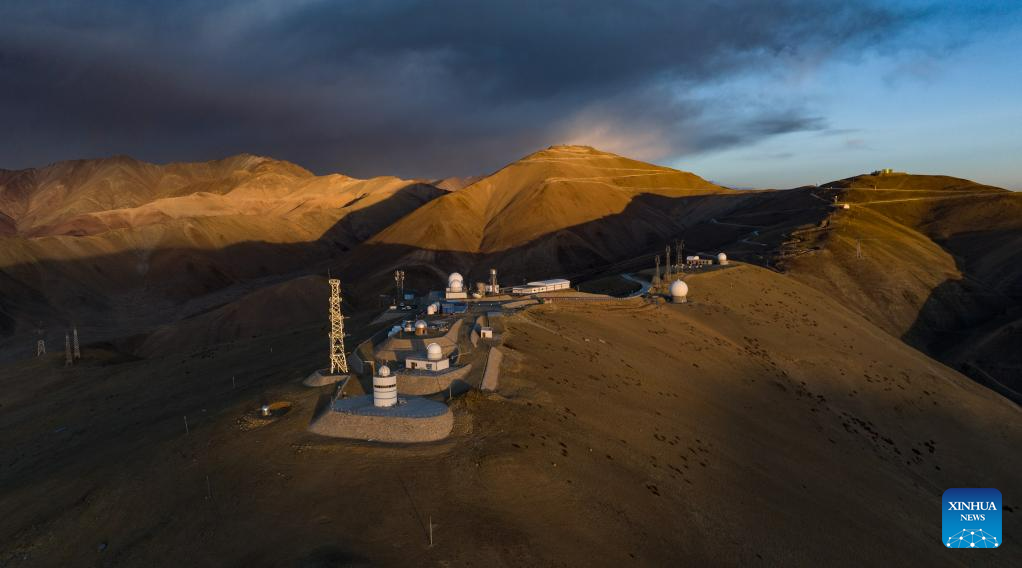
This photo taken on May 22, 2023 shows the Ngari Observatory at sunset in Ngari Prefecture, southwest China's Tibet Autonomous Region.
You Xianlong, a 36-year-old resident engineer at the Ngari Observatory in Tibet Autonomous Region, is responsible for equipment observation and operation maintenance along with seven colleagues. He is also the longest-serving engineer at the observatory.
You's career began in 2006 when he met Yao Yongqiang, a scientist at the National Astronomical Observatories under the Chinese Academy of Sciences (CAS), who was looking for workers to conduct long-term measurements in challenging plateau environments. Since then, You has been working at the Ngari Observatory for 17 years.
Selecting an observatory site is a complex process that involves examining terrain, geology, and support conditions. It also requires years of measurement and evaluation of factors such as the number of clear nights, astronomical seeing conditions, precipitable water vapor (PWV), and aerosol optical depth (AOD). These factors are closely related to astronomical observations.
Tibet's Ngari region, with an average altitude of over 4,500 meters, has proven to be an ideal location for establishing an astronomical observation base with full bandwidth.
From 2006 to 2011, the observatory's site selection team decided to construct an observation platform on a ridge south of Shiquanhe Town. You Xianlong and his colleagues took turns to keep a watch on the construction site. A typical round of shift would last at least three months.
During that period, You Xianlong and his colleagues faced a lot of difficulties such as limited food choices and threaten from wild animals.
In 2011, the observational platform was completed, marking the inception of the Ngari Observatory.
After over ten years of construction, the Ngari Observatory has now become one of the best astronomical observatories in the Northern Hemisphere. Yao Yongqiang believes that the facility will promote China's exploration into terrestrial planets and extraterrestrial life.
In the future, the observatory plans to build telescopes with diameters greater than ten meters. This prospect excites You Xianlong.
"I look forward to that day," said You Xianlong. "I am willing to stay on and prepare for the implementation of future large telescopes and scientific research projects." (Xinhua/Jigme Dorje)
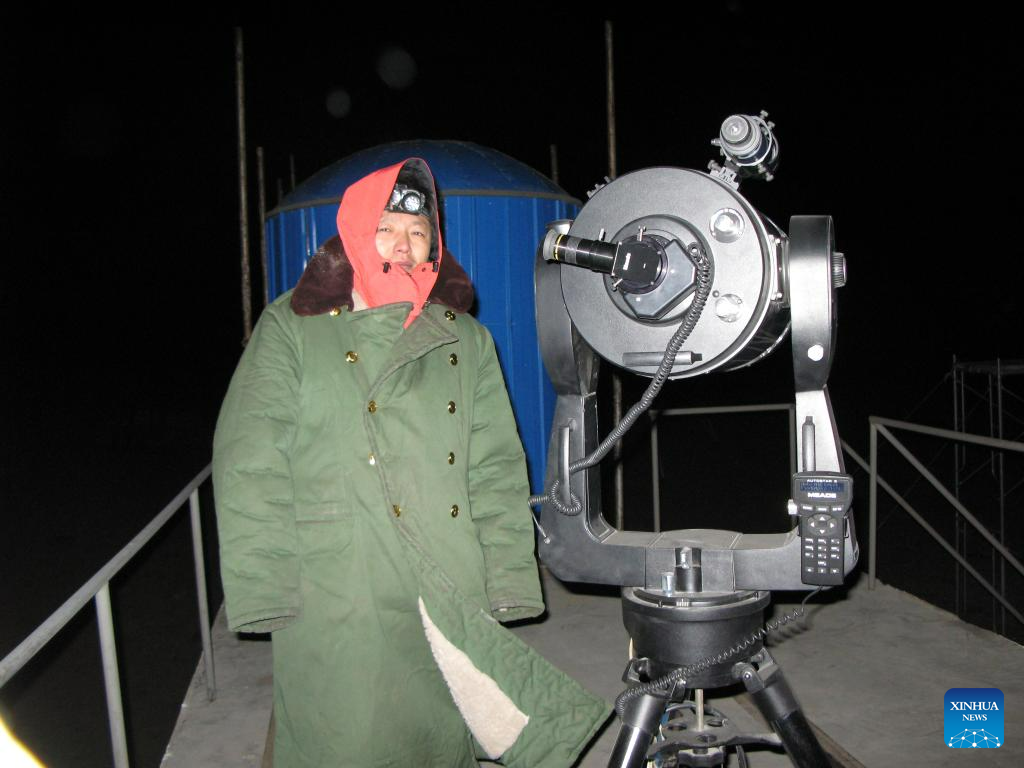
This file photo taken in December 2010 shows You Xianlong working at the Oma Observatory in Ngari Prefecture, southwest China's Tibet Autonomous Region.
You Xianlong, a 36-year-old resident engineer at the Ngari Observatory in Tibet Autonomous Region, is responsible for equipment observation and operation maintenance along with seven colleagues. He is also the longest-serving engineer at the observatory.
You's career began in 2006 when he met Yao Yongqiang, a scientist at the National Astronomical Observatories under the Chinese Academy of Sciences (CAS), who was looking for workers to conduct long-term measurements in challenging plateau environments. Since then, You has been working at the Ngari Observatory for 17 years.
Selecting an observatory site is a complex process that involves examining terrain, geology, and support conditions. It also requires years of measurement and evaluation of factors such as the number of clear nights, astronomical seeing conditions, precipitable water vapor (PWV), and aerosol optical depth (AOD). These factors are closely related to astronomical observations.
Tibet's Ngari region, with an average altitude of over 4,500 meters, has proven to be an ideal location for establishing an astronomical observation base with full bandwidth.
From 2006 to 2011, the observatory's site selection team decided to construct an observation platform on a ridge south of Shiquanhe Town. You Xianlong and his colleagues took turns to keep a watch on the construction site. A typical round of shift would last at least three months.
During that period, You Xianlong and his colleagues faced a lot of difficulties such as limited food choices and threaten from wild animals.
In 2011, the observational platform was completed, marking the inception of the Ngari Observatory.
After over ten years of construction, the Ngari Observatory has now become one of the best astronomical observatories in the Northern Hemisphere. Yao Yongqiang believes that the facility will promote China's exploration into terrestrial planets and extraterrestrial life.
In the future, the observatory plans to build telescopes with diameters greater than ten meters. This prospect excites You Xianlong.
"I look forward to that day," said You Xianlong. "I am willing to stay on and prepare for the implementation of future large telescopes and scientific research projects." (Xinhua)
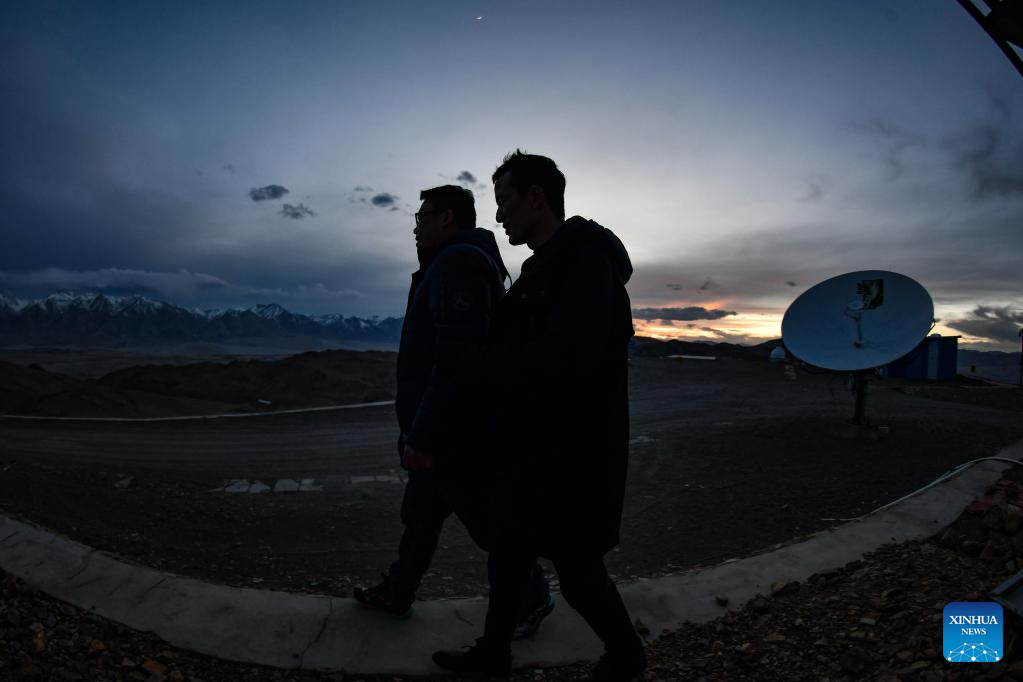
You Xianlong (R) and his colleague Tang Peng walk to a telescope awaiting maintenance at the Ngari Observatory in Ngari Prefecture, southwest China's Tibet Autonomous Region, May 23, 2023.
You Xianlong, a 36-year-old resident engineer at the Ngari Observatory in Tibet Autonomous Region, is responsible for equipment observation and operation maintenance along with seven colleagues. He is also the longest-serving engineer at the observatory.
You's career began in 2006 when he met Yao Yongqiang, a scientist at the National Astronomical Observatories under the Chinese Academy of Sciences (CAS), who was looking for workers to conduct long-term measurements in challenging plateau environments. Since then, You has been working at the Ngari Observatory for 17 years.
Selecting an observatory site is a complex process that involves examining terrain, geology, and support conditions. It also requires years of measurement and evaluation of factors such as the number of clear nights, astronomical seeing conditions, precipitable water vapor (PWV), and aerosol optical depth (AOD). These factors are closely related to astronomical observations.
Tibet's Ngari region, with an average altitude of over 4,500 meters, has proven to be an ideal location for establishing an astronomical observation base with full bandwidth.
From 2006 to 2011, the observatory's site selection team decided to construct an observation platform on a ridge south of Shiquanhe Town. You Xianlong and his colleagues took turns to keep a watch on the construction site. A typical round of shift would last at least three months.
During that period, You Xianlong and his colleagues faced a lot of difficulties such as limited food choices and threaten from wild animals.
In 2011, the observational platform was completed, marking the inception of the Ngari Observatory.
After over ten years of construction, the Ngari Observatory has now become one of the best astronomical observatories in the Northern Hemisphere. Yao Yongqiang believes that the facility will promote China's exploration into terrestrial planets and extraterrestrial life.
In the future, the observatory plans to build telescopes with diameters greater than ten meters. This prospect excites You Xianlong.
"I look forward to that day," said You Xianlong. "I am willing to stay on and prepare for the implementation of future large telescopes and scientific research projects." (Xinhua/Jigme Dorje)
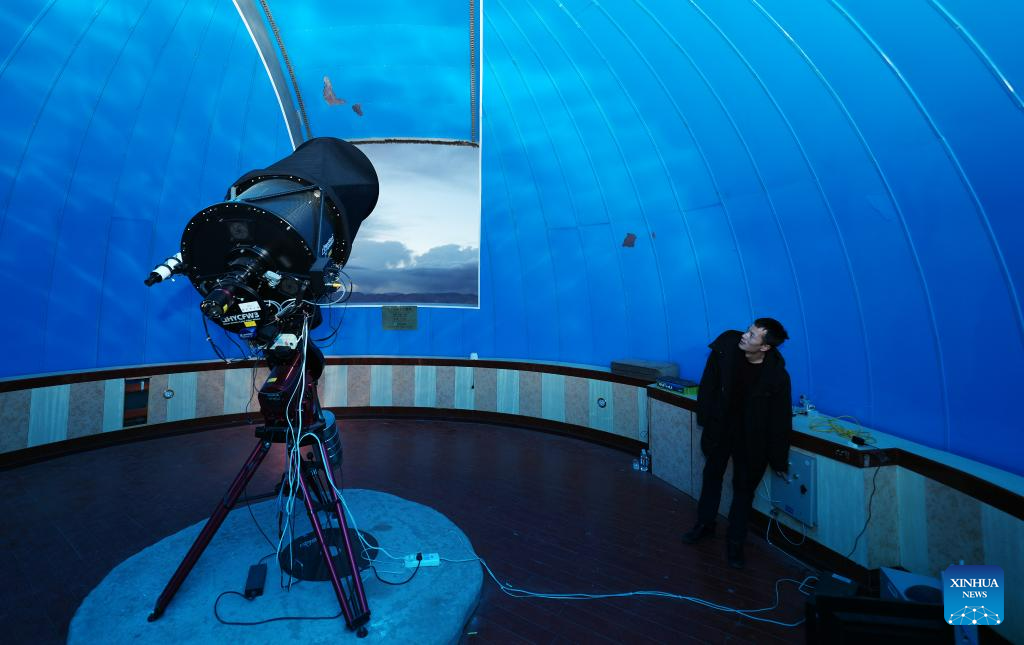
You Xianlong switches open a telescope dome at the Ngari Observatory in Ngari Prefecture, southwest China's Tibet Autonomous Region, May 24, 2023.
You Xianlong, a 36-year-old resident engineer at the Ngari Observatory in Tibet Autonomous Region, is responsible for equipment observation and operation maintenance along with seven colleagues. He is also the longest-serving engineer at the observatory.
You's career began in 2006 when he met Yao Yongqiang, a scientist at the National Astronomical Observatories under the Chinese Academy of Sciences (CAS), who was looking for workers to conduct long-term measurements in challenging plateau environments. Since then, You has been working at the Ngari Observatory for 17 years.
Selecting an observatory site is a complex process that involves examining terrain, geology, and support conditions. It also requires years of measurement and evaluation of factors such as the number of clear nights, astronomical seeing conditions, precipitable water vapor (PWV), and aerosol optical depth (AOD). These factors are closely related to astronomical observations.
Tibet's Ngari region, with an average altitude of over 4,500 meters, has proven to be an ideal location for establishing an astronomical observation base with full bandwidth.
From 2006 to 2011, the observatory's site selection team decided to construct an observation platform on a ridge south of Shiquanhe Town. You Xianlong and his colleagues took turns to keep a watch on the construction site. A typical round of shift would last at least three months.
During that period, You Xianlong and his colleagues faced a lot of difficulties such as limited food choices and threaten from wild animals.
In 2011, the observational platform was completed, marking the inception of the Ngari Observatory.
After over ten years of construction, the Ngari Observatory has now become one of the best astronomical observatories in the Northern Hemisphere. Yao Yongqiang believes that the facility will promote China's exploration into terrestrial planets and extraterrestrial life.
In the future, the observatory plans to build telescopes with diameters greater than ten meters. This prospect excites You Xianlong.
"I look forward to that day," said You Xianlong. "I am willing to stay on and prepare for the implementation of future large telescopes and scientific research projects." (Xinhua/Fei Maohua)
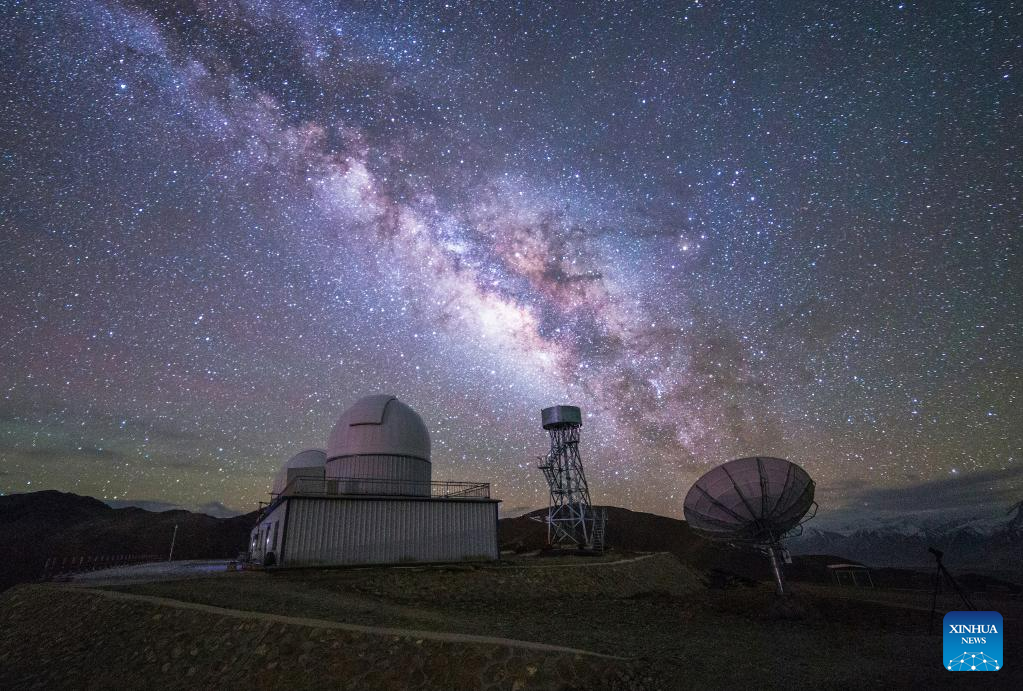
This file photo taken on April 23, 2017 shows the Ngari Observatory of the National Astronomical Observatories (NAO) in Ngari Prefecture, southwest China's Tibet Autonomous Region.
You Xianlong, a 36-year-old resident engineer at the Ngari Observatory in Tibet Autonomous Region, is responsible for equipment observation and operation maintenance along with seven colleagues. He is also the longest-serving engineer at the observatory.
You's career began in 2006 when he met Yao Yongqiang, a scientist at the National Astronomical Observatories under the Chinese Academy of Sciences (CAS), who was looking for workers to conduct long-term measurements in challenging plateau environments. Since then, You has been working at the Ngari Observatory for 17 years.
Selecting an observatory site is a complex process that involves examining terrain, geology, and support conditions. It also requires years of measurement and evaluation of factors such as the number of clear nights, astronomical seeing conditions, precipitable water vapor (PWV), and aerosol optical depth (AOD). These factors are closely related to astronomical observations.
Tibet's Ngari region, with an average altitude of over 4,500 meters, has proven to be an ideal location for establishing an astronomical observation base with full bandwidth.
From 2006 to 2011, the observatory's site selection team decided to construct an observation platform on a ridge south of Shiquanhe Town. You Xianlong and his colleagues took turns to keep a watch on the construction site. A typical round of shift would last at least three months.
During that period, You Xianlong and his colleagues faced a lot of difficulties such as limited food choices and threaten from wild animals.
In 2011, the observational platform was completed, marking the inception of the Ngari Observatory.
After over ten years of construction, the Ngari Observatory has now become one of the best astronomical observatories in the Northern Hemisphere. Yao Yongqiang believes that the facility will promote China's exploration into terrestrial planets and extraterrestrial life.
In the future, the observatory plans to build telescopes with diameters greater than ten meters. This prospect excites You Xianlong.
"I look forward to that day," said You Xianlong. "I am willing to stay on and prepare for the implementation of future large telescopes and scientific research projects." (NAO Ngari Observatory/Handout via Xinhua)
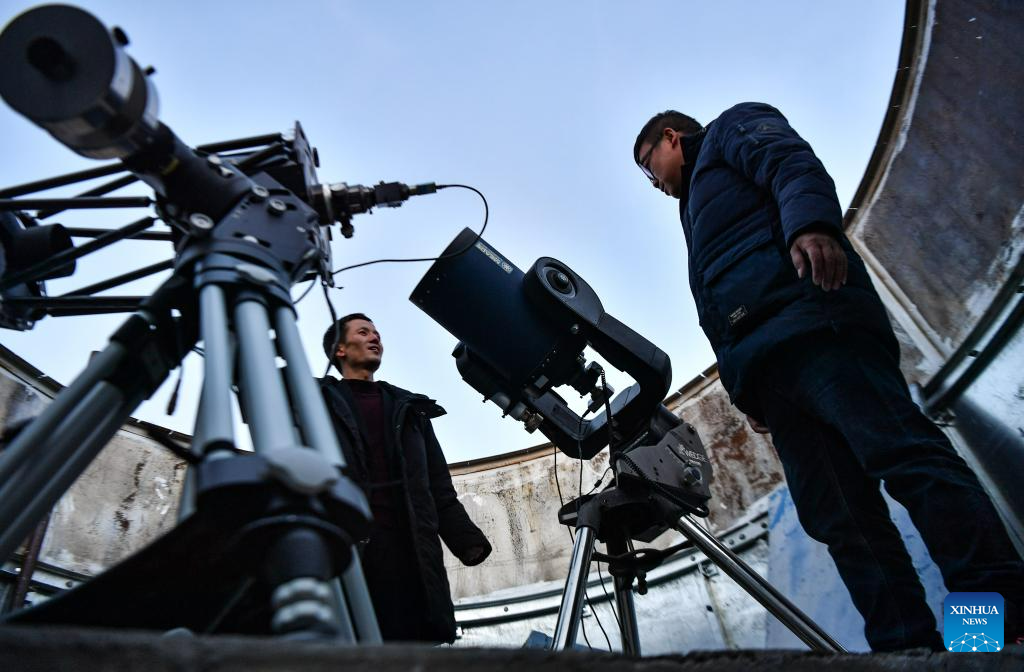
You Xianlong (L) and his colleague Tang Peng test a telescope at the Ngari Observatory in Ngari Prefecture, southwest China's Tibet Autonomous Region, May 23, 2023.
You Xianlong, a 36-year-old resident engineer at the Ngari Observatory in Tibet Autonomous Region, is responsible for equipment observation and operation maintenance along with seven colleagues. He is also the longest-serving engineer at the observatory.
You's career began in 2006 when he met Yao Yongqiang, a scientist at the National Astronomical Observatories under the Chinese Academy of Sciences (CAS), who was looking for workers to conduct long-term measurements in challenging plateau environments. Since then, You has been working at the Ngari Observatory for 17 years.
Selecting an observatory site is a complex process that involves examining terrain, geology, and support conditions. It also requires years of measurement and evaluation of factors such as the number of clear nights, astronomical seeing conditions, precipitable water vapor (PWV), and aerosol optical depth (AOD). These factors are closely related to astronomical observations.
Tibet's Ngari region, with an average altitude of over 4,500 meters, has proven to be an ideal location for establishing an astronomical observation base with full bandwidth.
From 2006 to 2011, the observatory's site selection team decided to construct an observation platform on a ridge south of Shiquanhe Town. You Xianlong and his colleagues took turns to keep a watch on the construction site. A typical round of shift would last at least three months.
During that period, You Xianlong and his colleagues faced a lot of difficulties such as limited food choices and threaten from wild animals.
In 2011, the observational platform was completed, marking the inception of the Ngari Observatory.
After over ten years of construction, the Ngari Observatory has now become one of the best astronomical observatories in the Northern Hemisphere. Yao Yongqiang believes that the facility will promote China's exploration into terrestrial planets and extraterrestrial life.
In the future, the observatory plans to build telescopes with diameters greater than ten meters. This prospect excites You Xianlong.
"I look forward to that day," said You Xianlong. "I am willing to stay on and prepare for the implementation of future large telescopes and scientific research projects." (Xinhua/Jigme Dorje)

This photo taken on May 24, 2023 shows the Ngari Observatory at sunset in Ngari Prefecture, southwest China's Tibet Autonomous Region.
You Xianlong, a 36-year-old resident engineer at the Ngari Observatory in Tibet Autonomous Region, is responsible for equipment observation and operation maintenance along with seven colleagues. He is also the longest-serving engineer at the observatory.
You's career began in 2006 when he met Yao Yongqiang, a scientist at the National Astronomical Observatories under the Chinese Academy of Sciences (CAS), who was looking for workers to conduct long-term measurements in challenging plateau environments. Since then, You has been working at the Ngari Observatory for 17 years.
Selecting an observatory site is a complex process that involves examining terrain, geology, and support conditions. It also requires years of measurement and evaluation of factors such as the number of clear nights, astronomical seeing conditions, precipitable water vapor (PWV), and aerosol optical depth (AOD). These factors are closely related to astronomical observations.
Tibet's Ngari region, with an average altitude of over 4,500 meters, has proven to be an ideal location for establishing an astronomical observation base with full bandwidth.
From 2006 to 2011, the observatory's site selection team decided to construct an observation platform on a ridge south of Shiquanhe Town. You Xianlong and his colleagues took turns to keep a watch on the construction site. A typical round of shift would last at least three months.
During that period, You Xianlong and his colleagues faced a lot of difficulties such as limited food choices and threaten from wild animals.
In 2011, the observational platform was completed, marking the inception of the Ngari Observatory.
After over ten years of construction, the Ngari Observatory has now become one of the best astronomical observatories in the Northern Hemisphere. Yao Yongqiang believes that the facility will promote China's exploration into terrestrial planets and extraterrestrial life.
In the future, the observatory plans to build telescopes with diameters greater than ten meters. This prospect excites You Xianlong.
"I look forward to that day," said You Xianlong. "I am willing to stay on and prepare for the implementation of future large telescopes and scientific research projects." (Xinhua/Fei Maohua)
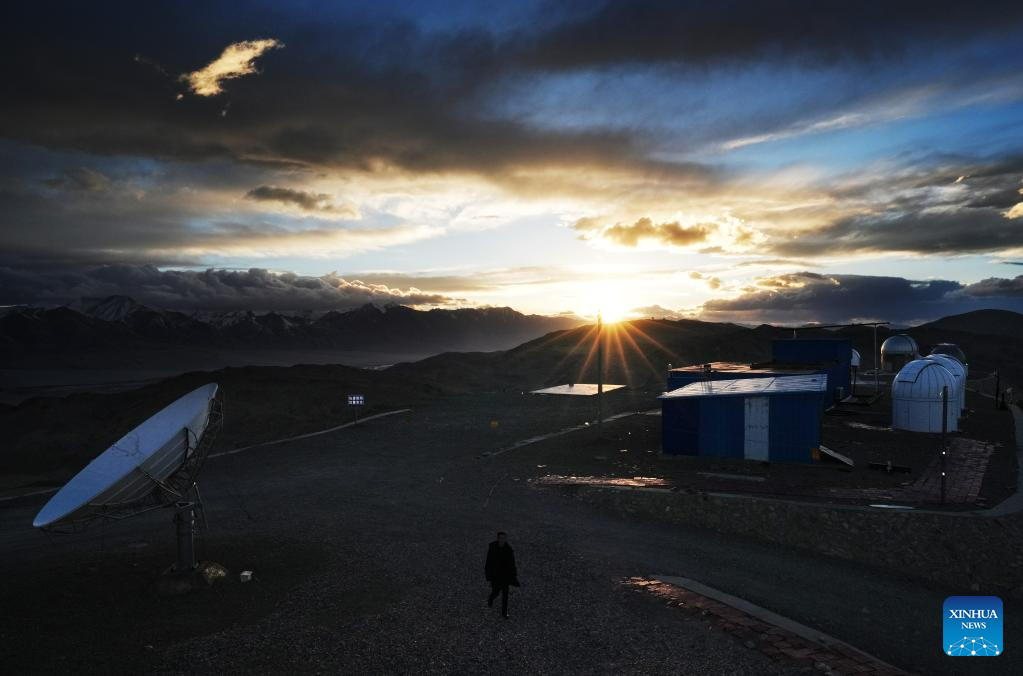
You Xianlong heads for his office at the Ngari Observatory in Ngari Prefecture, southwest China's Tibet Autonomous Region, May 24, 2023.
You Xianlong, a 36-year-old resident engineer at the Ngari Observatory in Tibet Autonomous Region, is responsible for equipment observation and operation maintenance along with seven colleagues. He is also the longest-serving engineer at the observatory.
You's career began in 2006 when he met Yao Yongqiang, a scientist at the National Astronomical Observatories under the Chinese Academy of Sciences (CAS), who was looking for workers to conduct long-term measurements in challenging plateau environments. Since then, You has been working at the Ngari Observatory for 17 years.
Selecting an observatory site is a complex process that involves examining terrain, geology, and support conditions. It also requires years of measurement and evaluation of factors such as the number of clear nights, astronomical seeing conditions, precipitable water vapor (PWV), and aerosol optical depth (AOD). These factors are closely related to astronomical observations.
Tibet's Ngari region, with an average altitude of over 4,500 meters, has proven to be an ideal location for establishing an astronomical observation base with full bandwidth.
From 2006 to 2011, the observatory's site selection team decided to construct an observation platform on a ridge south of Shiquanhe Town. You Xianlong and his colleagues took turns to keep a watch on the construction site. A typical round of shift would last at least three months.
During that period, You Xianlong and his colleagues faced a lot of difficulties such as limited food choices and threaten from wild animals.
In 2011, the observational platform was completed, marking the inception of the Ngari Observatory.
After over ten years of construction, the Ngari Observatory has now become one of the best astronomical observatories in the Northern Hemisphere. Yao Yongqiang believes that the facility will promote China's exploration into terrestrial planets and extraterrestrial life.
In the future, the observatory plans to build telescopes with diameters greater than ten meters. This prospect excites You Xianlong.
"I look forward to that day," said You Xianlong. "I am willing to stay on and prepare for the implementation of future large telescopes and scientific research projects." (Xinhua/Fei Maohua)

You Xianlong (L) and his colleague Tang Peng test a telescope at the Ngari Observatory in Ngari Prefecture, southwest China's Tibet Autonomous Region, May 23, 2023.
You Xianlong, a 36-year-old resident engineer at the Ngari Observatory in Tibet Autonomous Region, is responsible for equipment observation and operation maintenance along with seven colleagues. He is also the longest-serving engineer at the observatory.
You's career began in 2006 when he met Yao Yongqiang, a scientist at the National Astronomical Observatories under the Chinese Academy of Sciences (CAS), who was looking for workers to conduct long-term measurements in challenging plateau environments. Since then, You has been working at the Ngari Observatory for 17 years.
Selecting an observatory site is a complex process that involves examining terrain, geology, and support conditions. It also requires years of measurement and evaluation of factors such as the number of clear nights, astronomical seeing conditions, precipitable water vapor (PWV), and aerosol optical depth (AOD). These factors are closely related to astronomical observations.
Tibet's Ngari region, with an average altitude of over 4,500 meters, has proven to be an ideal location for establishing an astronomical observation base with full bandwidth.
From 2006 to 2011, the observatory's site selection team decided to construct an observation platform on a ridge south of Shiquanhe Town. You Xianlong and his colleagues took turns to keep a watch on the construction site. A typical round of shift would last at least three months.
During that period, You Xianlong and his colleagues faced a lot of difficulties such as limited food choices and threaten from wild animals.
In 2011, the observational platform was completed, marking the inception of the Ngari Observatory.
After over ten years of construction, the Ngari Observatory has now become one of the best astronomical observatories in the Northern Hemisphere. Yao Yongqiang believes that the facility will promote China's exploration into terrestrial planets and extraterrestrial life.
In the future, the observatory plans to build telescopes with diameters greater than ten meters. This prospect excites You Xianlong.
"I look forward to that day," said You Xianlong. "I am willing to stay on and prepare for the implementation of future large telescopes and scientific research projects." (Xinhua/Jigme Dorje)
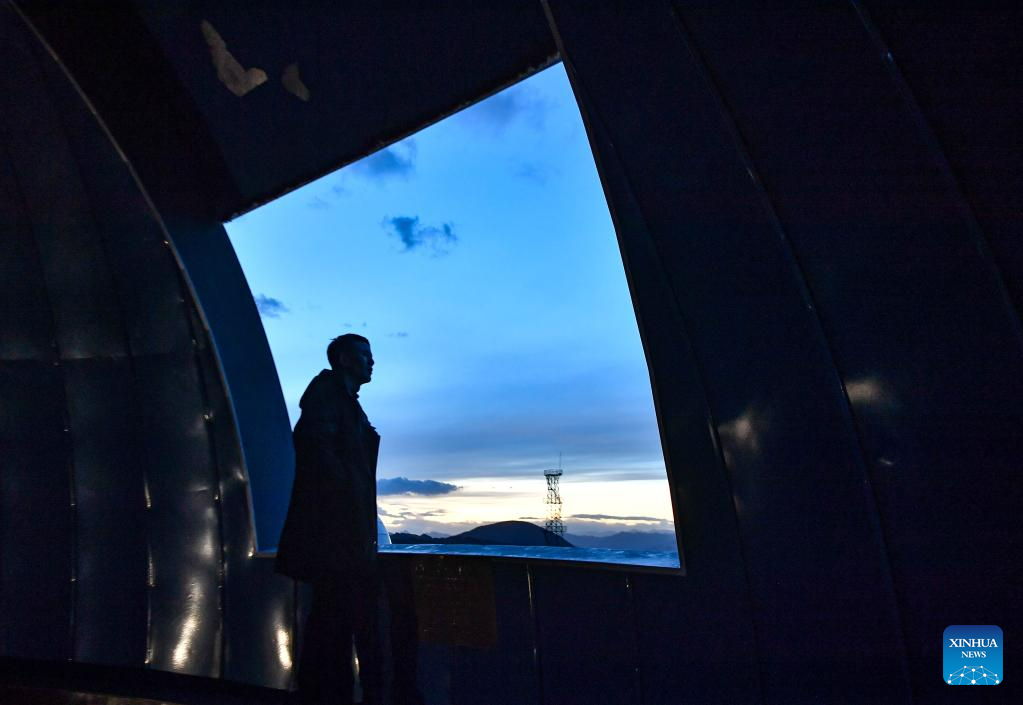
You Xianlong gazes into the night sky at the Ngari Observatory in Ngari Prefecture, southwest China's Tibet Autonomous Region, May 23, 2023.
You Xianlong, a 36-year-old resident engineer at the Ngari Observatory in Tibet Autonomous Region, is responsible for equipment observation and operation maintenance along with seven colleagues. He is also the longest-serving engineer at the observatory.
You's career began in 2006 when he met Yao Yongqiang, a scientist at the National Astronomical Observatories under the Chinese Academy of Sciences (CAS), who was looking for workers to conduct long-term measurements in challenging plateau environments. Since then, You has been working at the Ngari Observatory for 17 years.
Selecting an observatory site is a complex process that involves examining terrain, geology, and support conditions. It also requires years of measurement and evaluation of factors such as the number of clear nights, astronomical seeing conditions, precipitable water vapor (PWV), and aerosol optical depth (AOD). These factors are closely related to astronomical observations.
Tibet's Ngari region, with an average altitude of over 4,500 meters, has proven to be an ideal location for establishing an astronomical observation base with full bandwidth.
From 2006 to 2011, the observatory's site selection team decided to construct an observation platform on a ridge south of Shiquanhe Town. You Xianlong and his colleagues took turns to keep a watch on the construction site. A typical round of shift would last at least three months.
During that period, You Xianlong and his colleagues faced a lot of difficulties such as limited food choices and threaten from wild animals.
In 2011, the observational platform was completed, marking the inception of the Ngari Observatory.
After over ten years of construction, the Ngari Observatory has now become one of the best astronomical observatories in the Northern Hemisphere. Yao Yongqiang believes that the facility will promote China's exploration into terrestrial planets and extraterrestrial life.
In the future, the observatory plans to build telescopes with diameters greater than ten meters. This prospect excites You Xianlong.
"I look forward to that day," said You Xianlong. "I am willing to stay on and prepare for the implementation of future large telescopes and scientific research projects." (Xinhua/Jigme Dorje)
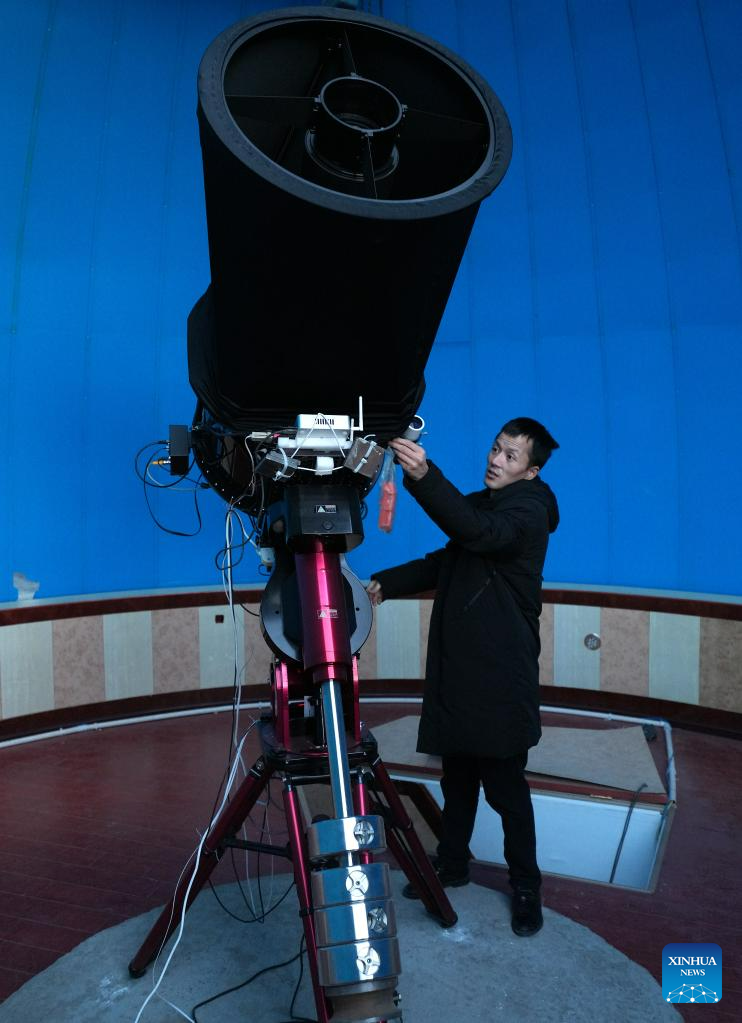
You Xianlong tests a telescope at the Ngari Observatory in Ngari Prefecture, southwest China's Tibet Autonomous Region, May 24, 2023.
You Xianlong, a 36-year-old resident engineer at the Ngari Observatory in Tibet Autonomous Region, is responsible for equipment observation and operation maintenance along with seven colleagues. He is also the longest-serving engineer at the observatory.
You's career began in 2006 when he met Yao Yongqiang, a scientist at the National Astronomical Observatories under the Chinese Academy of Sciences (CAS), who was looking for workers to conduct long-term measurements in challenging plateau environments. Since then, You has been working at the Ngari Observatory for 17 years.
Selecting an observatory site is a complex process that involves examining terrain, geology, and support conditions. It also requires years of measurement and evaluation of factors such as the number of clear nights, astronomical seeing conditions, precipitable water vapor (PWV), and aerosol optical depth (AOD). These factors are closely related to astronomical observations.
Tibet's Ngari region, with an average altitude of over 4,500 meters, has proven to be an ideal location for establishing an astronomical observation base with full bandwidth.
From 2006 to 2011, the observatory's site selection team decided to construct an observation platform on a ridge south of Shiquanhe Town. You Xianlong and his colleagues took turns to keep a watch on the construction site. A typical round of shift would last at least three months.
During that period, You Xianlong and his colleagues faced a lot of difficulties such as limited food choices and threaten from wild animals.
In 2011, the observational platform was completed, marking the inception of the Ngari Observatory.
After over ten years of construction, the Ngari Observatory has now become one of the best astronomical observatories in the Northern Hemisphere. Yao Yongqiang believes that the facility will promote China's exploration into terrestrial planets and extraterrestrial life.
In the future, the observatory plans to build telescopes with diameters greater than ten meters. This prospect excites You Xianlong.
"I look forward to that day," said You Xianlong. "I am willing to stay on and prepare for the implementation of future large telescopes and scientific research projects." (Xinhua/Fei Maohua)
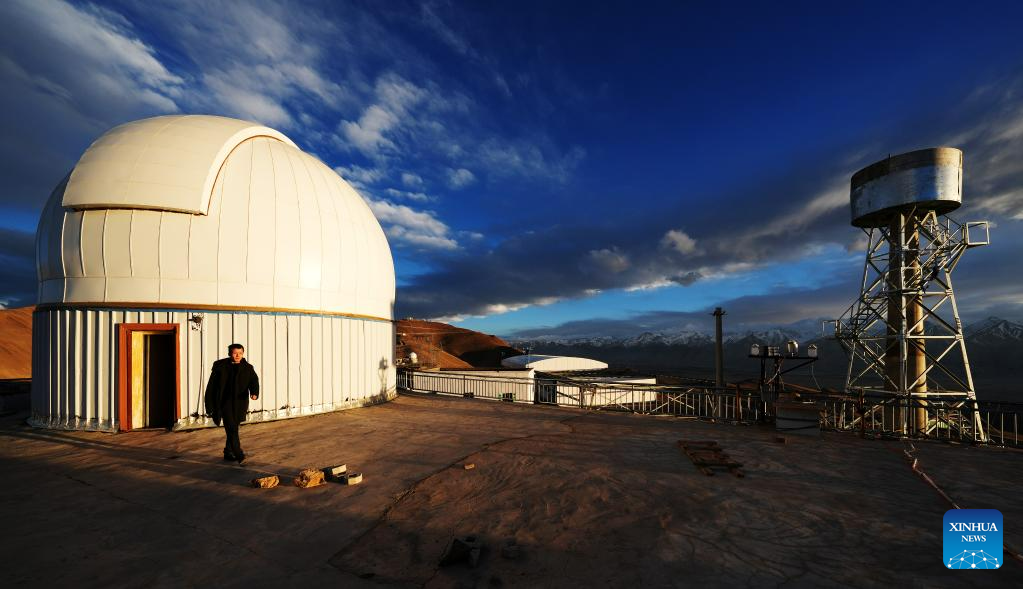
You Xianlong walks out a telescope dome at the Ngari Observatory in Ngari Prefecture, southwest China's Tibet Autonomous Region, May 24, 2023.
You Xianlong, a 36-year-old resident engineer at the Ngari Observatory in Tibet Autonomous Region, is responsible for equipment observation and operation maintenance along with seven colleagues. He is also the longest-serving engineer at the observatory.
You's career began in 2006 when he met Yao Yongqiang, a scientist at the National Astronomical Observatories under the Chinese Academy of Sciences (CAS), who was looking for workers to conduct long-term measurements in challenging plateau environments. Since then, You has been working at the Ngari Observatory for 17 years.
Selecting an observatory site is a complex process that involves examining terrain, geology, and support conditions. It also requires years of measurement and evaluation of factors such as the number of clear nights, astronomical seeing conditions, precipitable water vapor (PWV), and aerosol optical depth (AOD). These factors are closely related to astronomical observations.
Tibet's Ngari region, with an average altitude of over 4,500 meters, has proven to be an ideal location for establishing an astronomical observation base with full bandwidth.
From 2006 to 2011, the observatory's site selection team decided to construct an observation platform on a ridge south of Shiquanhe Town. You Xianlong and his colleagues took turns to keep a watch on the construction site. A typical round of shift would last at least three months.
During that period, You Xianlong and his colleagues faced a lot of difficulties such as limited food choices and threaten from wild animals.
In 2011, the observational platform was completed, marking the inception of the Ngari Observatory.
After over ten years of construction, the Ngari Observatory has now become one of the best astronomical observatories in the Northern Hemisphere. Yao Yongqiang believes that the facility will promote China's exploration into terrestrial planets and extraterrestrial life.
In the future, the observatory plans to build telescopes with diameters greater than ten meters. This prospect excites You Xianlong.
"I look forward to that day," said You Xianlong. "I am willing to stay on and prepare for the implementation of future large telescopes and scientific research projects." (Xinhua/Fei Maohua)

This photo taken on May 24, 2023 shows the Ngari Observatory at night in Ngari Prefecture, southwest China's Tibet Autonomous Region.
You Xianlong, a 36-year-old resident engineer at the Ngari Observatory in Tibet Autonomous Region, is responsible for equipment observation and operation maintenance along with seven colleagues. He is also the longest-serving engineer at the observatory.
You's career began in 2006 when he met Yao Yongqiang, a scientist at the National Astronomical Observatories under the Chinese Academy of Sciences (CAS), who was looking for workers to conduct long-term measurements in challenging plateau environments. Since then, You has been working at the Ngari Observatory for 17 years.
Selecting an observatory site is a complex process that involves examining terrain, geology, and support conditions. It also requires years of measurement and evaluation of factors such as the number of clear nights, astronomical seeing conditions, precipitable water vapor (PWV), and aerosol optical depth (AOD). These factors are closely related to astronomical observations.
Tibet's Ngari region, with an average altitude of over 4,500 meters, has proven to be an ideal location for establishing an astronomical observation base with full bandwidth.
From 2006 to 2011, the observatory's site selection team decided to construct an observation platform on a ridge south of Shiquanhe Town. You Xianlong and his colleagues took turns to keep a watch on the construction site. A typical round of shift would last at least three months.
During that period, You Xianlong and his colleagues faced a lot of difficulties such as limited food choices and threaten from wild animals.
In 2011, the observational platform was completed, marking the inception of the Ngari Observatory.
After over ten years of construction, the Ngari Observatory has now become one of the best astronomical observatories in the Northern Hemisphere. Yao Yongqiang believes that the facility will promote China's exploration into terrestrial planets and extraterrestrial life.
In the future, the observatory plans to build telescopes with diameters greater than ten meters. This prospect excites You Xianlong.
"I look forward to that day," said You Xianlong. "I am willing to stay on and prepare for the implementation of future large telescopes and scientific research projects." (Xinhua/Fei Maohua)
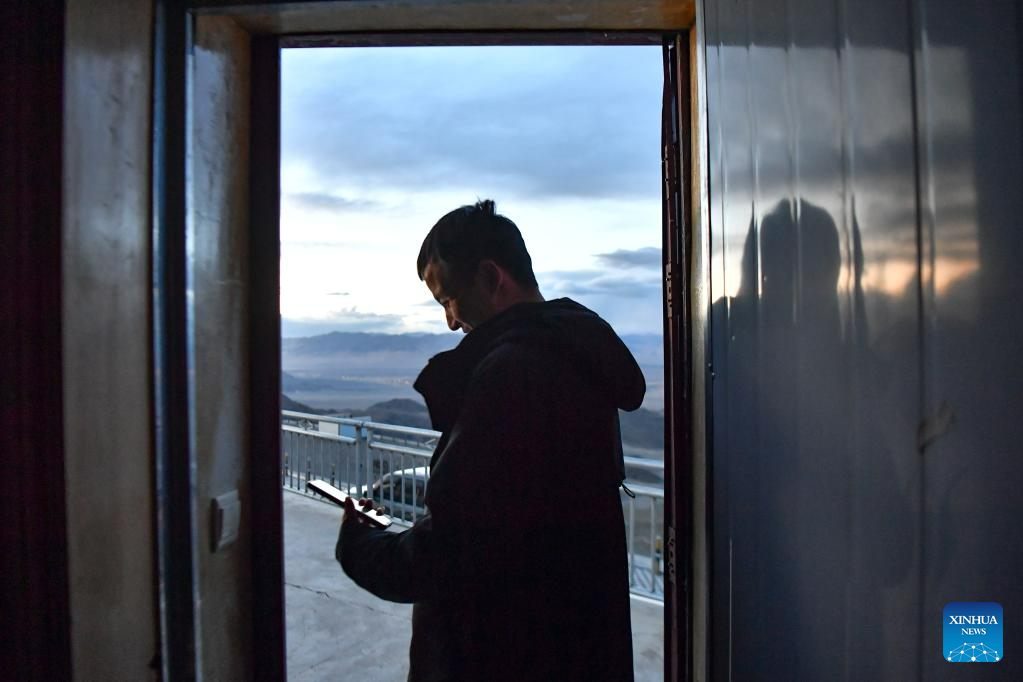
You Xianlong talks with his family over the mobile phone at the Ngari Observatory in Ngari Prefecture, southwest China's Tibet Autonomous Region, May 24, 2023.
You Xianlong, a 36-year-old resident engineer at the Ngari Observatory in Tibet Autonomous Region, is responsible for equipment observation and operation maintenance along with seven colleagues. He is also the longest-serving engineer at the observatory.
You's career began in 2006 when he met Yao Yongqiang, a scientist at the National Astronomical Observatories under the Chinese Academy of Sciences (CAS), who was looking for workers to conduct long-term measurements in challenging plateau environments. Since then, You has been working at the Ngari Observatory for 17 years.
Selecting an observatory site is a complex process that involves examining terrain, geology, and support conditions. It also requires years of measurement and evaluation of factors such as the number of clear nights, astronomical seeing conditions, precipitable water vapor (PWV), and aerosol optical depth (AOD). These factors are closely related to astronomical observations.
Tibet's Ngari region, with an average altitude of over 4,500 meters, has proven to be an ideal location for establishing an astronomical observation base with full bandwidth.
From 2006 to 2011, the observatory's site selection team decided to construct an observation platform on a ridge south of Shiquanhe Town. You Xianlong and his colleagues took turns to keep a watch on the construction site. A typical round of shift would last at least three months.
During that period, You Xianlong and his colleagues faced a lot of difficulties such as limited food choices and threaten from wild animals.
In 2011, the observational platform was completed, marking the inception of the Ngari Observatory.
After over ten years of construction, the Ngari Observatory has now become one of the best astronomical observatories in the Northern Hemisphere. Yao Yongqiang believes that the facility will promote China's exploration into terrestrial planets and extraterrestrial life.
In the future, the observatory plans to build telescopes with diameters greater than ten meters. This prospect excites You Xianlong.
"I look forward to that day," said You Xianlong. "I am willing to stay on and prepare for the implementation of future large telescopes and scientific research projects." (Xinhua/Jigme Dorje)



